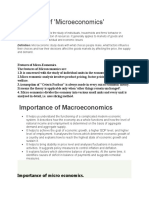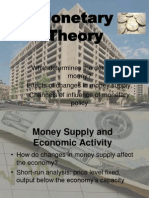Micro and Macro
Uploaded by
yogeshMicro and Macro
Uploaded by
yogeshEconomic analysis is of two types (a) Micro economic analysis and (b) Macro
economic analysis
a) Definition of Micro economics:
According to E. Boulding, “Micro economics is the study of particular firm, particular
household, individual price, wage, income, industry, and particular commodity.”
In the words of Leftwitch, “Micro economics is concerned with the economic activities of
such economic units as consumers, resource owners and business firms.”
• ‘Micro’ is a Greek word means ‘small’.
• Micro economic theory studies the behaviour of individual decision-making units
such as consumers’ resource owners, business firms, individual households,
wages of workers, etc.
• It studies the flow of economic resources or factors of production from the
resource owners to business firms and the flow of goods and services from the
business firms to households. It studies the composition of such flows and how
the prices of goods and services in the flow are determined.
• In this analysis economists pick up a small unit and observe the details of its
operation.
• It provides analytical tools for the study of the behaviour of market mechanism.
• It is also called as Price theory and
• It is also called as Partial Equilibrium analysis.
Conclusion: Micro economics has been defined as that branch where the unit of study is
an individual, firm or household. It studies how individual make their choices about what
to produce, how to produce, and for whom to produce, and what price to charge. It is also
known as the price theory is the main source of concepts and analytical tools for
managerial decision making. Various micro economic concepts such as demand, supply,
elasticity of demand and supply, marginal cost, various market forms, etc. are of great
significance to managerial economics.
Importance of Micro economics:
• Micro economics occupies a very important place in the study of economic
theory.
• It has both theoretical and practical importance.
• It explains the functioning of a free enterprise economy.
• It tells how millions of consumers and producers in an economy take decisions
about the allocation of productive resources among millions of goods and
services.
• It explains how through market mechanism goods and services produced in the
community are distributed.
• It explains the determination of the relative prices of the various products and
productive services.
• It helps in the formulation of economic policies calculated to promote efficiency
in production and the welfare of the masses.
Limitations of Micro economics:
• It cannot give an idea of the functioning of the economy as a whole. An individual
industry may be flourishing, where as the economy as a whole may be
languishing.
• It assumes full employment which is a rare phenomenon, at any rate in the
capitalist world. Therefore it is an unrealistic assumption.
b) Definition of Macro economics:
According to E. Boulding “Macro economics deals not with individual quantities as such
but with aggregates of these quantities, not with individual income but with national
income not with individual prices but with price levels, not with individual outputs but
with national output.”
According to Gardner Ackely, “Macro economics concerns with such variables as the
aggregate volume of the output of an economy, with the extent to which its resources are
employed, with the size of national income and with the general price level.”
• Macro economics is the obverse of microeconomics.
• It is the study of economic system as a whole.
• It studies not one economic unit like a firm or an industry but the whole economic
system.
• Therefore it deals with totals or aggregates national income output and
employment, total consumption, saving and investment and the genera level of
prices.
• It is also called as Income theory and
• It is also called as aggregative economics.
Conclusion: Macro economics studies the economics as a whole. It is aggregative in
character and takes the entire economic as a unit of study. Macro economics helps in the
area of forecasting. It includes National Income, aggregate consumption, investments,
employment etc.
Importance of Macro economics:
• It helps in understanding the functioning of a complicated economic system
• It gives a bird’s eye view of the economic world
• For the formulation of useful economic policies for the nation macro economics is
of the utmost significance.
• It is far more fruitful to regulate aggregate employment and national income and
to work out a national wage policy
• It occupies most important place in economic theory in its pursuit of the solution
of urgent economic problems.
Limitations of Macro economics:
• Individual is ignored altogether. It is individual welfare which is the main aim of
economics.
• It overlooks individual differences. Say the general price level may be stable, but
the price of food grains may have gone spelling ruin to the poor.
Difference between Micro economics and Macro economics:
The main differences between micro economics and macro economics are the following:
S.no Micro economics Macro economics
1. Difference in the degreeIt studies the individual unitsIt deals with aggregates like
of aggregation: of the economy like a firm, anational income and
particular commodity. aggregate savings. It studies
the problem of the economy
as a whole
2. Difference in objectives It is to study of principles,It studies the problems,
problems and policiespolicies and principles
concerning the optimumrelating full employment of
allocation of resources resources and growth of
resources.
3. Difference of subjectIt deals with the determinationIt is full employment,
matter of price, consumer’snational income, general
equilibrium, distribution andprice-level, trade cycles,
welfare, etc. economic growth, etc.
4. Method of study Micro economics lawsMacro economics elements
establish relationship betweenare categorized into
the causes and effects ofaggregate units like
economics phenomena and itaggregate demand,
is formulated by taking someaggregate supply, total
assumptions. consumption, total
investment, etc.
5. Different assumptions It analysis how productionIt analysis how full
and factors of production areemployment can be
allocated among differentachieved.
uses.
6. Difference of the forcesIt studies the equilibriumIt deals with equilibrium
of equilibrium between the forces ofbetween the forces demand
individual demand and supplyand supply of whole
or market demand and supply. economy.
You might also like
- ECON 101 Lecture 1 - The Ten Principles of EconomicsNo ratings yetECON 101 Lecture 1 - The Ten Principles of Economics32 pages
- ECON 101 Lecture 3 - The Market Forces of Demand & SupplyNo ratings yetECON 101 Lecture 3 - The Market Forces of Demand & Supply57 pages
- ECO2201 - Slides - 3.1 - Demand and SupplyNo ratings yetECO2201 - Slides - 3.1 - Demand and Supply68 pages
- The Data of Macroeconomics: AcroeconomicsNo ratings yetThe Data of Macroeconomics: Acroeconomics54 pages
- A Reflection On The Global Capital MarketNo ratings yetA Reflection On The Global Capital Market1 page
- Full Download Principles of Economics 8th Edition N Gregory Mankiw PDF DOCX100% (4)Full Download Principles of Economics 8th Edition N Gregory Mankiw PDF DOCX66 pages
- Lecture 1 - Trade in The Global EconomyNo ratings yetLecture 1 - Trade in The Global Economy30 pages
- Energy Economics - II Jeffrey Frankel: Harpel Professor, Harvard UniversityNo ratings yetEnergy Economics - II Jeffrey Frankel: Harpel Professor, Harvard University61 pages
- Principals of E: Conomics N. Gregory MankiwNo ratings yetPrincipals of E: Conomics N. Gregory Mankiw22 pages
- Module 1 Introduction To Economics and Managerial Economics100% (1)Module 1 Introduction To Economics and Managerial Economics61 pages
- Course Outline - Business Statistics and Basic Econometrics PDFNo ratings yetCourse Outline - Business Statistics and Basic Econometrics PDF3 pages
- Chapter-One Overview of Public Finance & TaxationNo ratings yetChapter-One Overview of Public Finance & Taxation211 pages
- Unit 14 - Unemployment and Fiscal Policy - 1.0No ratings yetUnit 14 - Unemployment and Fiscal Policy - 1.041 pages
- Topic 2 - National Income Accounting and The Balance of PaymentsNo ratings yetTopic 2 - National Income Accounting and The Balance of Payments28 pages
- Chapter 13 National Income Accounting and The Balance of PaymentsNo ratings yetChapter 13 National Income Accounting and The Balance of Payments51 pages
- ECON 391 Economics of The Environment: Natural Capital, Linkages Between The Economy and The Environment, and PollutionNo ratings yetECON 391 Economics of The Environment: Natural Capital, Linkages Between The Economy and The Environment, and Pollution32 pages
- Ew Macro Lecture 2: Consumption, Investment, and Government and Income Determination0% (1)Ew Macro Lecture 2: Consumption, Investment, and Government and Income Determination47 pages
- Numericals On National Income Accounting 2019-20No ratings yetNumericals On National Income Accounting 2019-202 pages
- 1.Introduction to micro and macro economics 12thstd_055de719-39cc-41fc-9be6-21e299ff1cfbNo ratings yet1.Introduction to micro and macro economics 12thstd_055de719-39cc-41fc-9be6-21e299ff1cfb3 pages
- LinkedIn Message Scripts - Yogesh ChabriaNo ratings yetLinkedIn Message Scripts - Yogesh Chabria6 pages
- IC e Commerce Sales Forecast Template 10708No ratings yetIC e Commerce Sales Forecast Template 107083 pages
- The Best Combination of Attributes and Levels of A SmartphoneNo ratings yetThe Best Combination of Attributes and Levels of A Smartphone20 pages
- Exercise On Marginal Costing and Cost GÇôVolume Profit AnalysisNo ratings yetExercise On Marginal Costing and Cost GÇôVolume Profit Analysis4 pages
- University of Rizal System: Graduate SchoolNo ratings yetUniversity of Rizal System: Graduate School54 pages
- Market: Business Superbrands-2nd Edition (Main) 8/27/08 3:50 AM Page 94No ratings yetMarket: Business Superbrands-2nd Edition (Main) 8/27/08 3:50 AM Page 942 pages

























































































